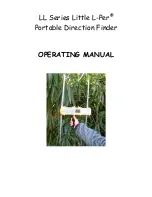
6
In the DF mode, the antenna is rapidly
switched, first to the left and then the right.
The strength of the signal while pointing left
is subtracted from the strength while point-
ing right and the result is shown by a dark-
ening on the horizontal bar on the display to
show the direction of strongest signal. Thus,
if the signal source is to the right of the DF,
the bar will darken the pointer to the right.
Turn in the direction the bar indicates until it
nearly disappears or points equally left and
right. The operator is now facing the signal
source. Any further turn in the same direc-
tion (right) and the bar will darken to the op-
posite side (left). Return to the centered in-
dication to face the signal source. A “buzz”
heard in the DF mode is normal.
In DF mode, the larger of left and right
signals is selected for signal strength indi-
cation. This makes the strength reading
nearly independent of antenna angle (omni-
directional). DF mode should be used for
the signal strength or build and fade method
of transmitter location,
Figure 3 shows the operating screen in
DF mode with the various condition indica-
tors.
Figure 3. L-Per
®
Operating Screen in the
DF Mode.
In the Receive mode, the antennas act
as a directional beam that is most sensitive
off the left end of the receiver. In this mode,
selected by the REC/DF key, the received
signal will have the greatest strength when
the left end of the receiver front panel is
pointed at the source. This maximum signal
is rather broad but may be useful when only
a general direction is needed.
The DF will show one or more minimum
amplitude points, often called nulls, but
these change depending on tuning and
should not be used for determining direc-
tion. This mode also eliminates the “buzz”
present in the DF mode and makes speech
easier to understand. A numerical indication
supplements the vertical bar to indicate sig-
nal strength, with about 400 being the
weakest signal and about 850 the strongest.
Figure 4. L-Per
®
Operating Screen in the
Receive Mode.
Details on operating in both the DF and
Receive modes are covered in the Direction
Finding Techniques section (page 13).
When a vehicle is equipped with two sets
of L-Tronics
®
DF antennas, one mounted
fore-aft and the second left-right, the coax
leads are connected to the appropriate BNC
jacks on top of the receiver. The display on
the DF then allows the fore/aft and left/right
bars to be displayed simultaneously to give
a continuous “all around” indication in the
DF mode.
DETAILS ON OPERATION
DF receivers intended for operation in
the United States have three standard
emergency frequencies and one practice
frequency pre-programmed in the memory:
1.
121.500
ELT-1 AM
2.
243.000
ELT-2 AM
3.
121.775
TRAINING AM
4
156.800
MARINE FM
Some receivers built for export and spe-
cial operations may be programmed differ-
ently.

































